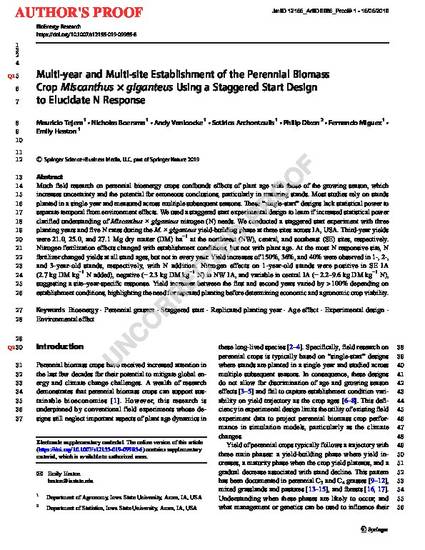
Much field research on perennial bioenergy crops confounds effects of plant age with those of the growing season, which increases uncertainty and the potential for erroneous conclusions, particularly in maturing stands. Most studies rely on stands planted in a single year and measured across multiple subsequent seasons. These “single-start” designs lack statistical power to separate temporal from environment effects.We used a staggered start experimental design to learn if increased statistical power clarified understanding of Miscanthus × giganteus nitrogen (N) needs. We conducted a staggered start experiment with three planting years and five N rates during the M. × giganteus yield-building phase at three sites across IA, USA. Third-year yields were 21.0, 25.0, and 27.1 Mg dry matter (DM) ha−1 at the northwest (NW), central, and southeast (SE) sites, respectively. Nitrogen fertilization effects changed with establishment conditions, but not with plant age. At the most N responsive site, N fertilizer changed yields at all stand ages, but not in every year. Yield increases of 150%, 36%, and 40% were observed in 1-, 2-, and 3-year-old stands, respectively, with N addition. Nitrogen effects on 1-year-old stands were positive in SE IA (2.7 kg DM kg−1 N added), negative (− 2.3 kg DM kg−1 N) in NW IA, and variable in central IA (− 2.2–9.6 kg DM kg−1 N), suggesting a site–year-specific response. Yield increases between the first and second years varied by > 100% depending on establishment conditions, highlighting the need for repeated planting before determining economic and agronomic crop viability.
Available at: http://works.bepress.com/emily-heaton/67/

This is a manuscript of an article published as Tejera, M., Boersma, N., Vanloocke, A. et al. Multi-year and Multi-site Establishment of the Perennial Biomass Crop Miscanthus × giganteus Using a Staggered Start Design to Elucidate N Response. Bioenerg. Res. 12, 471–483 (2019). doi: 10.1007/s12155-019-09985-6. Posted with permission.